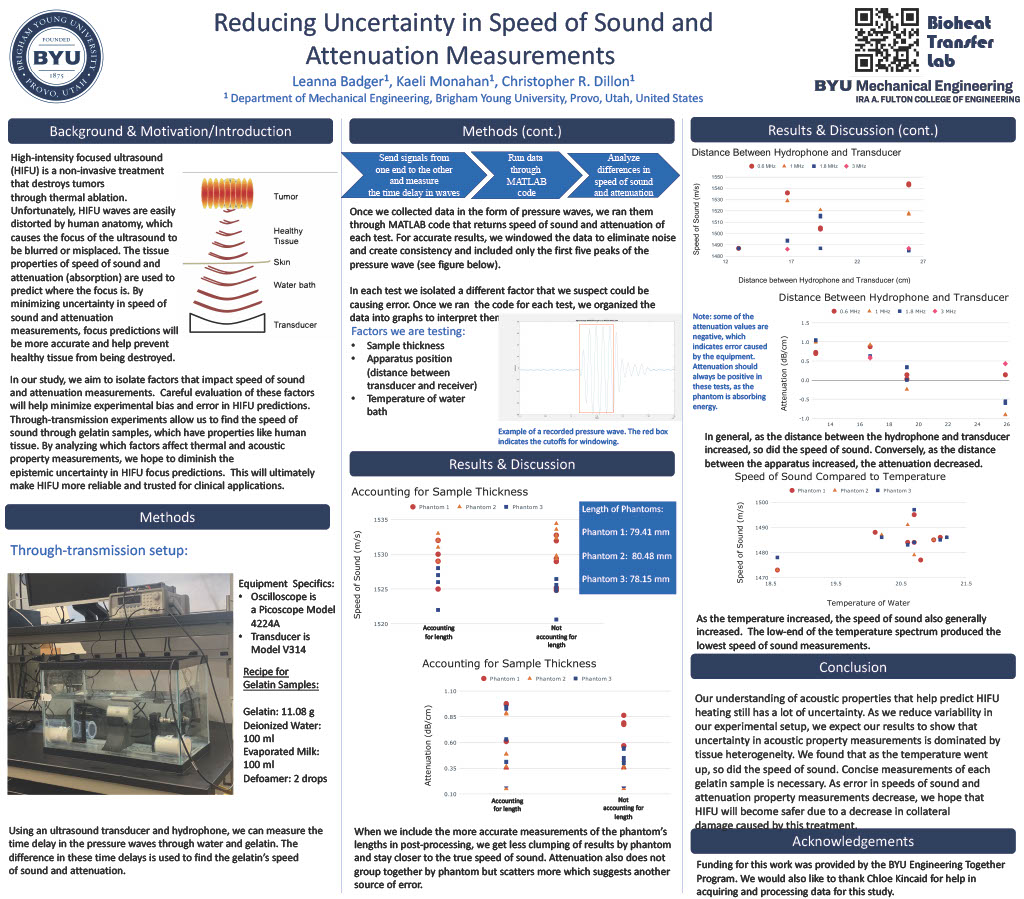Presenter Name: Kaeli Monahan
Additional Presenters:
Leanna Badger
Description
Background: High-intensity focused ultrasound (HIFU) is a non-invasive treatment that destroys tumors through thermal ablation. Unfortunately, HIFU waves are easily distorted by human anatomy, which causes the focus of the ultrasound to be blurred or misplaced. The tissue properties of speed of sound and attenuation are used to predict where the focus is. By minimizing uncertainty in speed of sound and attenuation measurements, focus predictions will be more accurate and help prevent healthy tissue from being destroyed.
Purpose: In our study, we aim to isolate factors that impact speed of sound and attenuation measurements. Experimental factors include sample thickness, sample position, apparatus position, and water quality. Careful evaluation of these factors will help minimize experimental bias and error in HIFU predictions. Through-transmission experiments allow us to find the speed of sound through gelatin samples, which have properties like human tissue. Using an ultrasound transducer and hydrophone, we can measure the time delay in the pressure waves through water and gelatin. The difference in these time delays is used to find the gelatin's speed of sound and attenuation. Through analyzing which factors affect these property measurements and which do not, we hope to diminish the epistemic uncertainty in HIFU focus predictions. This will ultimately make HIFU more reliable and trusted for clinical applications.
Preliminary Results: Initial testing suggests that factors contributing to measurement error consist of movement of the apparatus, the size of the specimen, and variation of gelatin sample composition. Adjusting the distance between the transducer and hydrophone also had an impact on measuring speed of sound. More accurate measurements of the length of each gelatin sample produced more accurate speed of sound results. When comparing multiple measurements in several gelatin samples, speed of sound measurements varied from sample to sample, where some were consistently higher and others lower. This suggests a difference in the material itself, even for samples made from the same gelatin batch.
Conclusion: HIFU is a revolutionary, minimally invasive treatment. However, our understanding of acoustic properties that help predict HIFU heating still has a lot of uncertainty. As we reduce variability in our experimental setup, we expect our results to show that uncertainty in acoustic property measurements is dominated by tissue heterogeneity. As error in speeds of sound and attenuation property measurements decrease, we hope that HIFU will become safer due to a decrease in collateral damage caused by this treatment.
University / Institution: Brigham Young University
Type: Poster
Format: In Person
Presentation #B23
SESSION B (10:45AM-12:15PM)
Area of Research: Engineering
Email: kaelimonahan2247@gmail.com
Faculty Mentor: Christopher Dillon

